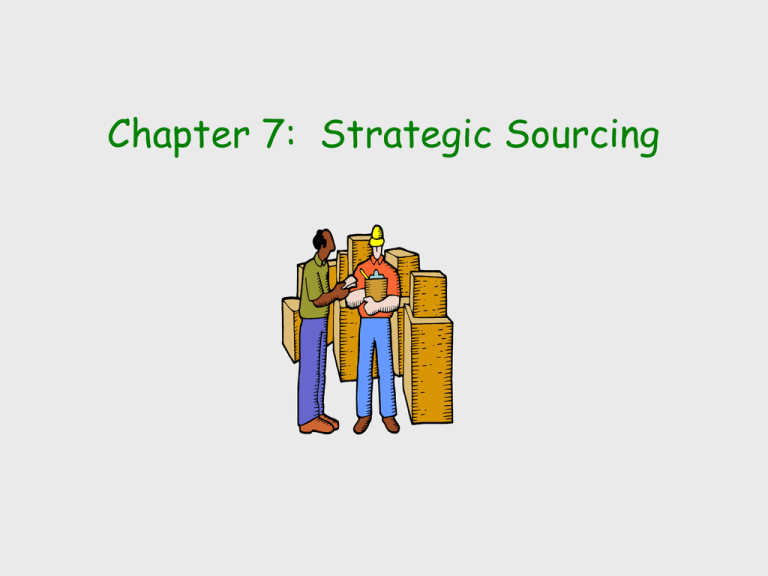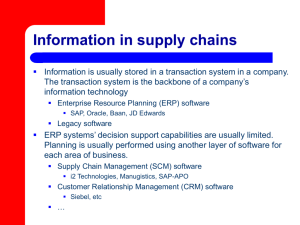10. ENTERPRISE NETWORKING & THE INTERNET
advertisement

Chapter 7: Strategic Sourcing Strategic Sourcing Strategic Sourcing is the development and management of supplier relationships to acquire goods and services in a way that aids in achieving the immediate needs of the business Ford Manufacturing Supply Chain http://www.covisint.com/ What is the bullwhip effect? Demand variability increases as you move up the supply chain from customers towards supply Equipment Tier 1 Supplier Factory Distributor First noticed regarding Pampers Retailer Customer Bullwhip effect in the US PC supply chain Changes in demand 80% 60% Semiconductor Equipment 40% 20% PC 0% -20% Semiconductor -40% 1995 1996 1997 1998 1999 2000 2001 Annual percentage changes in demand (in $s) at three levels of the semiconductor supply chain: personal computers, semiconductors and semiconductor manufacturing equipment. Consequences of the bullwhip effect Inefficient production or excessive inventory. Low utilization of the distribution channel. Necessity to have capacity far exceeding average demand. High transportation costs. Poor customer service due to stockouts. Causes of the bullwhip effect Order synchronization Order batching Trade promotions and forward buying Reactive and over-reactive ordering Shortage gaming Order synchronization 70 Customers order on the same order cycle, e.g., first of the month, every Monday, etc. 50 40 Units The graph shows simulated daily consumer demand (solid line) and supplier demand (squares) when retailers order weekly: 9 retailers order on Monday, 5 on Tuesday, 1 on Wednesday, 2 or Thursday and 3 on Friday. 60 30 20 10 0 T im e (e a c h p e rio d e q u a ls o n e d a y ) Order batching 70 The graph shows simulated daily consumer demand (solid line) and supplier demand (squares) when retailers order in batches of 15 units, i.e., every 15th demand a retailer orders one batch from the supplier that contains 15 units. 60 50 Units Retailers may be required to order in integer multiples of some batch size, e.g., case quantities, pallet quantities, full truck load, etc. 40 30 20 10 0 T im e (e a c h p e rio d e q u a ls o n e d a y ) Trade promotions and forward buying Supplier gives retailer a temporary discount, called a trade promotion. Retailer purchases enough to satisfy demand until the next trade promotion. Example: Campbell’s Chicken Noodle Soup over a one year period: Total shipments and consumption One retailer’s buy 7000 6000 S hipm e nts Cases Cases 5000 4000 3000 C ons um ption 2000 1000 Nov Oct Sep Aug Jul Jun Apr Mar Feb May T im e (w e e ks ) Jan Dec 0 Reactive and over-reactive ordering Each location forecasts demand to determine shifts in the demand process. How should a firm respond to a “high” demand observation? ä Is this a signal of higher future demand or just random variation in current demand? ä Hedge by assuming this signals higher future demand, i.e. order more than usual. Rational reactions at one level propagate up the supply chain. Unfortunately, it is human to over react, thereby further increasing the bullwhip effect. Shortage gaming Setting: ä Retailers submit orders for delivery in a future period. ä Supplier produces. ä If supplier production is less than orders, orders are rationed, i.e., retailers are “put on allocation”. … to secure a better allocation, the retailers inflate their orders, i.e., order more than they need… … So retailer orders do not convey good information about true demand … This can be a big problem for the supplier, especially if retailers are later able to cancel a portion of the order: ä Orders that have been submitted that are likely be canceled are called phantom orders. Strategies to combat the bullwhip effect Information sharing: ä Collaborative Planning, Forecasting and Replenishment (CPFR) Smooth the flow of products ä Coordinate with retailers to spread deliveries evenly. ä Reduce minimum batch sizes. ä Smaller and more frequent replenishments (EDI). Eliminate pathological incentives ä Every day low price ä Restrict returns and order cancellations ä Order allocation based on past sales in case of shortages Vendor Managed Inventory (VMI): delegation of stocking decisions ä Used by Barilla, P&G/Wal-Mart and others. Supply Chain Design Strategy Based on concepts developed by Marshall Fischer at Wharton (Penn) Functional Products ä Staples that people buy at retail outlets ä Predictable demand and long life cycles ä Physical costs ä Strategy: Minimize physical costs Innovative Products ä Life cycle is just a few months (e.g. fashion clothes & computers) ä Demand is unpredictable ä Market mediation costs (inventory & stockouts) ä Strategy: Maximize responsiveness & flexibility Hau Lee’s Concepts of Supply Chain Management Hau Lee’s approach to supply chain (SC) is one of aligning SC’s with the uncertainties revolving around the supply process side of the SC A stable supply process has mature technologies and an evolving supply process has rapidly changing technologies Types of SC’s ä Efficient SC’s ä Risk-Hedging SC’s ä Responsive SC’s ä Agile SC’s Hau Lee’s SC Uncertainty Framework Demand Uncertainty Supply Uncertainty Low (Stable Process) High (Evolving Process) Low (Functional products) High (Innovative products) Efficient SC Responsive SC Ex.: Grocery Ex.: Computers Risk-Hedging SC Agile SC Ex.: Hydro-electric power Ex.: Telecom Outsourcing Outsourcing is defined as the act of moving a firm’s internal activities and decision responsibility to outside providers Reasons to Outsource ä Organizationally-driven ä Improvement-driven ä Financially-driven ABC News Report on Outsourcing Part 2 Inventory Turnover Obtaining data ä Look up inventory value on the balance sheet ä Look up cost of goods sold (COGS) from earnings statement – not sales!! Common benchmark is inventory turns ä Inventory Turns = COGS/ Inventory Value A manufacturing company producing medical devices reported $60 million in sales last year. At the end of the year, they had $20 million worth of inventory in ready-to ship devices. Assuming that units are valued at $1000 per unit and sold at $2000 per unit, what is the turnover rate? Sales = $60,000,000 per year / $2000 per unit = 30,000 units sold per year @ $1000 COGS per unit Inventory = $20,000,000 / $1000 per unit = 20,000 units in inventory Turns = COGS/Inventory = $30,000,000/$20,000,000 = 1.5 turns Inventory Turnover Statistics Industries with higher gross margins tend to have lower inventory turns Wholesale Retail Hardware stores: 3.5 Retail Nurseries & Garden Supply: 3.3 General Merchandise Stores: 4.7 Groceries & related: 17.8 Vehicles & automotive: 6.9 Furniture & fixtures: 5.5 Sporting goods: 4.8 Grocery Stores: 12.7 Drug store items: 8.5 New & Used Car Dealers: 6.8 Apparel & related: 5.5 Gas stations & mini-marts: 39.3 Petroleum & related: 42.4 Apparel & Alcoholic beverages: 8.5 Accessories: 3.5 Furniture & home furnishings: 4.1 Drug Stores: 5.3 Liquor Stores: 6.6 Other Retail Stores: 4.3 Source: Bizstats.com Value Density Value density is defined as the value of an item per pound of weight ä It is used as an important measure when deciding where items should be stocked geographically and how they should be shipped Mass Customization Mass customization is a term used to describe the ability of a company to deliver highly customized products and services to different customers ä The key to mass customization is effectively postponing the tasks of differentiating a product for a specific customer until the latest possible point in the supplychain network











